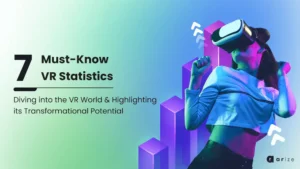As a leading supplier of AR products and experiences in the metaverse, we must be pretty savvy about the technology and its development. From producing individual products to full-blown Metaverse experiences, we use technology to help bring clients’ products to life.
While many people see AR as a single, solid phenomenon, it is pretty varied, and five distinct types of AR are used in different sectors in different ways. So, let’s look at the different types of AR and bring you up to speed!
Marker-Based AR
Marker-based AR showcases content using a specific point or target – most commonly a QR code. You use your mobile app and your camera to activate it.
Whenever you scan the QR code, it detects and recognizes the AR marker and replaces it with the corresponding object the marker represents. A widespread use is to translate words seen through your camera. Marker-based AR is currently one of the most widely used types of AR.
Location-Based AR
Also known as “markerless” or “geo-location” based AR, this is probably the best-known AR type, thanks to games like Pokémon Go and Harry Potter Wizards Unite.
Again, this technology uses a mobile device and may require the specific use of an app. It uses your device’s GPS instead of physical markers.
This will allow in-app content to be displayed at specific coordinates, making it ideal for the travel and tourism business. For example, the City Guide Tour app provides sightseeing information, restaurant reviews, and other helpful information overlaid on its maps to help tourists.
Outlining AR
Outlining AR displays auxiliary information over a real-life scenario to enhance or improve the experience by tracking an object and constantly reorienting it in real time.
This format is handy for drivers on the road. As more and more vehicles incorporate tech features based on safety, instruments like dashboard cams and parking cameras can heighten awareness in potentially hazardous situations.
Projection-Based AR
Projection-based AR is the most advanced form of AR in the sector. We would categorize it as a hologram, although it requires a physical object to be projected onto an additional layer.
Although it mimics how superimposition AR works (which we shall look at now), the user needs no screen or mobile device to experience the enhanced object view.
Projection-based AR has a multitude of use cases. It is instrumental in product design, where you can test a new look for a product without changing it physically to see the result, saving time and money.
You can also design and show clients new products in the initial stages without building a prototype to bring them to life.
Superimposition AR
This augmented reality type lets users view a physical object with an additional digital layer. As the name suggests, this technology superimposes. Either wholly or partially – visual media onto a different surface, offering an alternate view.
Our technology uses AR to allow our clients to showcase their products to customers similarly. See what a painting would look like in your home or the best place to put a sofa. Our technology brings e-commerce to life with no additional software or apps.




